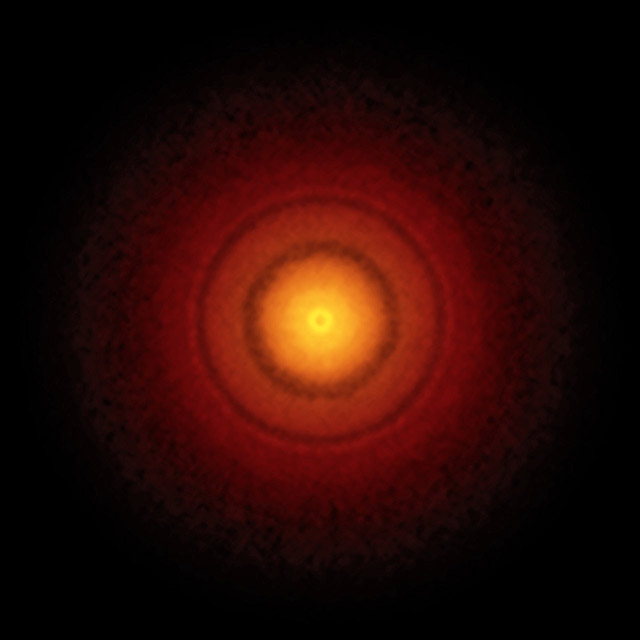Scientists from Japan and the USA have finally scaled the solar system's equivalent of the Rocky Mountain range.

ALMA image of the disc around the young star TW Hydrae
ALMA of the nearby young star TW Hydrae reveals the classic rings and gaps that signify planets are in formation in this system.
Credit: S. Andrews (Harvard-Smithsonian CfA); B. Saxton (NRAO/AUI/NSF); ALMA (ESO/NAOJ/NRAO)
In a study published recently in Nature Astronomy, the researchers unveil the possible origins of our cosmic neighbourhood's ‘Great Divide'. This well-known schism may have partitioned the solar system just after the Sun first formed.
The phenomenon is similar to how the Rocky Mountains divide North America into east and west. On one side are ‘terrestrial' planets like Earth and Mars, which are made of fundamentally different types of materials than the more distant ‘jovians', such as Jupiter and Saturn.
‘The question is: how do you create this compositional dichotomy?' said lead author Ramon Brasser, a researcher at the Earth-Life Science Institute (ELSI) at the Tokyo Institute of Technology in Japan. ‘How do you ensure that material from the inner and outer solar system didn't mix from very early on in its history?'
Brasser and co-author Stephen Mojzsis, a professor in the University of Colorado Boulder's Department of Geological Sciences, think they have the answer, and it may just shed new light on how life originated on Earth.
The Sun's gaseous disc holds vital clues
The duo suggests that the early solar system was partitioned into at least two regions by a ring-like structure in the disc around the young sun. This ring may have major implications for the evolution of planets and asteroids, and even the history of life on Earth.
‘The most likely explanation for that compositional difference is that it emerged from an intrinsic structure of this disc of gas and dust', Mojzsis said.
Mojzsis noted that the Great Divide, a term that he and Brasser coined, does not look like much today. It is a relatively empty stretch of space that sits near Jupiter, just beyond the asteroid belt.
But you can still detect its presence throughout the solar system. Move sunwards from that line, and most planetary building blocks (asteroids and meteorites) tend to carry relatively low abundances of water and organic molecules. Go the other direction, towards Jupiter and beyond Neptune, and a different picture emerges: almost everything in this distant part of the solar system is made up of materials that are rich in carbon and water ice.
This dichotomy ‘was really a surprise when it was first found', Mojzsis said.
Many scientists assumed that Jupiter was the agent responsible for that surprise. The thinking went that the planet is so massive that it may have acted as a gravitational barrier, preventing icy pebbles and dust from the outer solar system from spiralling towards the sun.
But Brasser and Mojzsis were not convinced. The scientists used a series of computer simulations to explore Jupiter's role in the evolving solar system. They found that while Jupiter is big, it was probably never big enough early in its formation to entirely block the flow of icy material from moving sunwards.
‘We banged our heads against the wall', Brasser said. ‘If Jupiter wasn't the agent responsible for creating and maintaining that compositional dichotomy, what else could be?'
A solution in plain sight
For years, scientists operating an observatory in Chile called the Atacama Large Millimeter/submillimeter Array (ALMA) had noticed something unusual around distant stars: young stellar systems, they found, were often surrounded by discs of gas and dust that, in infrared light, look a bit like a tiger's eye.
If a similar ring existed in our solar system billions of years ago, Brasser and Mojzsis reasoned, it could theoretically be responsible for the Great Divide.
Such a ring would create alternating bands of high- and low-pressure gas and dust. Those bands, in turn, might pull the solar system's earliest building blocks into several distinct sinks—one that would have given rise to Jupiter and Saturn, and another possibly Uranus and Neptune.
In the Rocky Mountains, ‘the Great Divide causes water to drain one way or another', Mojzsis said. ‘It's similar to how this pressure bump would have divided material' in the solar system.
But, he added, there's a caveat: that barrier in space was most likely imperfect. Some outer solar system material may still have climbed across the divide. And those fugitives could have been important for the evolution of our world.
‘Those materials that might go to the Earth would be those volatile, carbon-rich materials from the outer solar system', Mojzsis said. ‘And that gives you water. It gives you organics.'
The rest is Earth history.

Giant planet formation in the solar system
A schematic diagram of the possible ringed structure of the Sun's protoplanetary disk and the formation of the giant planets.
Credit: Lucy Kwok (ELSI)
Reference
Authors : |
R. Brasser1, and S. J. Mojzsis2.3 |
Title of original paper : |
The partitioning of the inner and outer solar system by a structured protoplanetary disk |
Journal : |
Nature Astronomy |
DOI : |
|
Affiliations : |
1Earth-Life Science Institute, Tokyo Institute of Technology, Ookayama, Meguro-ku, Tokyo 152-8550, Japan
2Department of Geological Sciences, University of Colorado, Boulder, Colorado 80309-0399, USA
3Institute for Geological and Geochemical Research, Research Centre for Astronomy and Earth Sciences, Hungarian Academy of Sciences, 45 Budarsi Street, H-1112 Budapest, Hungary
|
. Any information published on this site will be valid in relation to Science Tokyo.




